Last Updated on 13/10/2025
Gujarat is dotted all over with over 100 stepwells. They represent the bygone era in the form of intricate designs, skillful finish, and artistic architecture. Being the land of color, vibrancy and an eclectic lifestyle these stepwells are a major part of the wonderfully colorful Gujarati culture.
In the olden times, these stepwells not only provided water for the locals to carry on with their daily life but they were also a place of socialization and mingling. People used to come here to discuss their life, chit-chat a while, and then leave. Some of these elaborately made stepwells also have sculptures of various gods and goddesses which shows that Gujarat has always been a deeply religious state with an incredible spiritual bend.
The stepwells of Gujarat are hugely underrated when it comes to places of interest here. In fact, going to any one of these stepwells will make you realize that there is more to Gujarat than just Garba, temples, and the Great Rann Of Kutch.
- Adalaj Stepwell (Gandhinagar)
- Dada Harir Stepwell (Ahmedabad)
- Wankaner Palace Stepwell (Rajkot)
- Adi Kadi Vav (Junagadh)
- Navlakha Vav (Vadodara)
- Geban Shah’s Vav (Champaner)
- Modhera Surya Kund (Ahmedabad)
- Rani Ki Vav (Patan)
- Ramkund Stepwell (Bhuj)
1. Adalaj Stepwell (Gandhinagar)

The stepwell draws its name from the village this heritage spot is located in. A fine example of Indian architecture at its finest, Adalaj vav was built in Indo-Islamic style during 1498. The stepwell was constructed by queen Rudadevi in memory of her late husband Rana Veer Singh. Along with a water reservoir, it was also a spiritual refuge which is clear with the sculptures and engravings dedicated to spirituality. Octagonal in shape it was also a place where the locals offered prayers to the lord at the idols of deities present here. This structure is a symbol of Hindu and Jain faith and inside the stepwell, you can actually feel the air being almost 6 degrees cooler than outside. One of the highlights of this place is the finely carved-out image of a Kalpa Vriksha on a single slab of stone.
2. Dada Harir Stepwell (Ahmedabad)
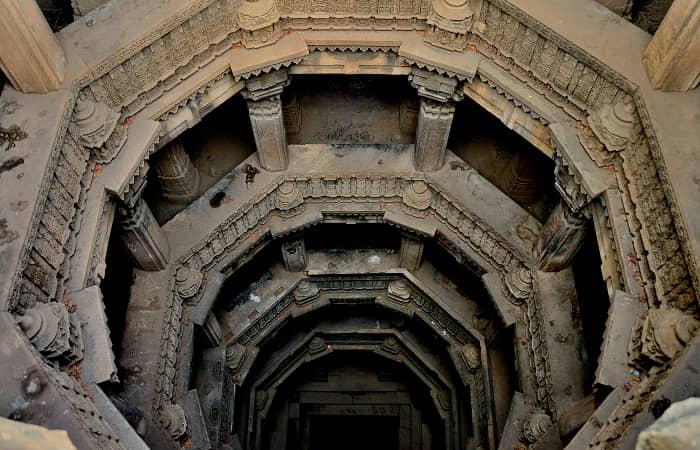
Another fine example of expert Indian architecture is located 15 kms away from Ahmedabad. Dada Harir Vav was built in the year 1485 by Dhai Harir who was a superintendent of the royal harem. The well has 2 inscriptions one in Sanskrit and one in Arabic. Built using sandstone and in Solanki style of architecture, this vav is also octagonal in shape, decorated heavily with intricately carved out pillars holding it. Every floor is widely spaced out which seemed indicative of space to allow people to gather and Socialise. Dating back to around 500 years ago, and consisting of several different floors, this palace is best experienced in the morning light. Although this place remains almost largely neglected it should be visited to see the unique features and to learn about how people back then socialized.
3. Wankaner Palace Stepwell (Rajkot)
Gracing the bend of Machhu River, Wankaner Palace stands out amidst the beautiful, wide, and open surroundings. It was built by the erstwhile British rulers during the 1930s and was used as a cool place for the royal family of Gujarat to retreat during the scorching summer heat season. Known for being one of its kind, Wankaner Palace Stepwell was built in white sandstone and currently remains one of the lesser-visited places in Gujarat. It is a fine example of a well-preserved heritage structure. Currently, the palace itself functions as a high-end palatial hotel but its glory remains intact. Wankaner is situated in Rajkot which is around 200 kms away from Ahmedabad. You either choose to stay at one of the hotel rooms here or plan a day visit to the palace and check out some nearby places of interest in Gujarat as well.
4. Adi Kadi Vav (Junagadh)
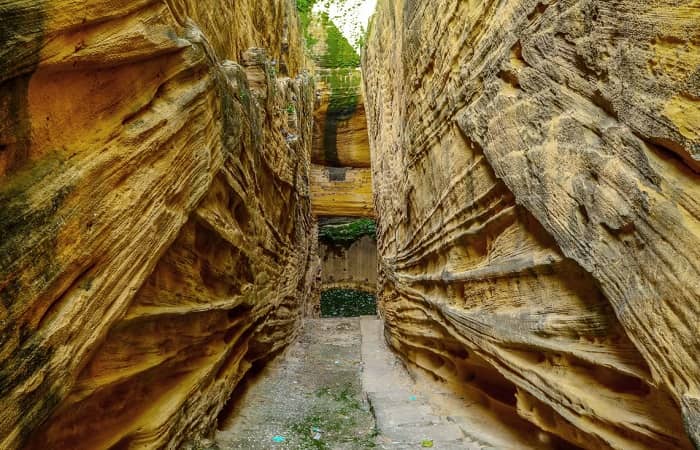
Built-in the 15th century, although Adi Kadi Vav lacks the glorious intricacies of other stepwells, its history and value remains unmatched. This is one of the oldest stepwells in India and a true testament to the engineering style and smart thinking of the ancient Indian civilization. This stepwell is cut out of a single block of stone and also contains sculptures on pillars. The legend of the vav involves 2 maidens who were sacrificed under the pretext that doing so would fill up the stepwell with water. Stepwells are considered to be one of the most breakthrough developments in human progress. It is situated at a distance of around 330 kms from Ahmedabad and around some of the most amazing tourist destinations in Gujarat like Somnath Temple and Porbandar which is the home of Mahatma Gandhi.
5. Navlakha Vav (Vadodara)
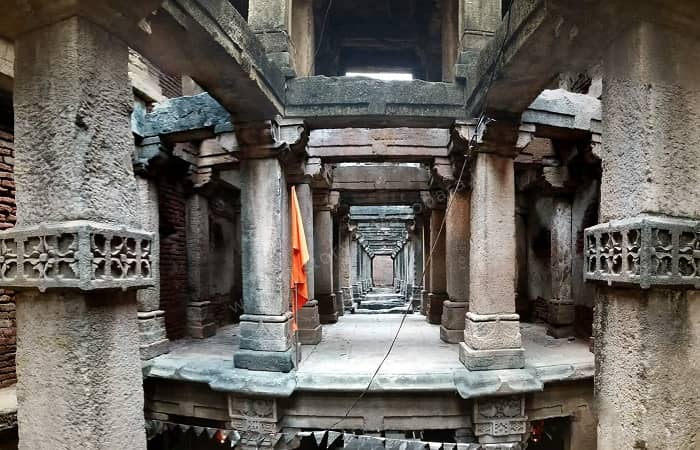
Located in one of the most iconic palaces of Gujarat, Laxmi Vilas is the Navlakha Vav. This structure is probably the only remainder of the once-Gurjar rule in Gujarat. Built during the 15th century by Sultan Muzaffar Shah the floors of the vav are intricately carved out with the lower floors being covered in Brahmi script. The stepwell got its name from the fact that 9 lakh gold coins were spent in its construction. Dating back to around 600 plus years, this vav is a must-visit to get a glimpse into the colorful and interesting past of this wonderful state. Located near Porbandar in Ghumli, it is a good place to go with your family on your way to Porbandar.
6. Geban Shah’s Vav (Champaner)
This is probably one of the most unique stepwells in Gujarat. Located in the iconic UNESCO World Heritage site of Champaner Pavagadh, this stepwell is applauded for its sophisticated water management system. It was so efficiently managed that the people residing in those never went without water, be it summer or drought season. Built during the 16th century by a fakir who went by the name of Gebanshah. With minimal ornamentation unlike the other stepwells in the state, the length pans out in an area of 50 meters on the ground floor or the lowest level. This is a simple-looking nanda-style vav which is humble, simple, and smart. This shows the forward-thinking and innovative ideas of our ancestors. This was built for use by the community with the soil in the bottom acting as a natural filter.
7. Modhera Surya Kund (Ahmedabad)
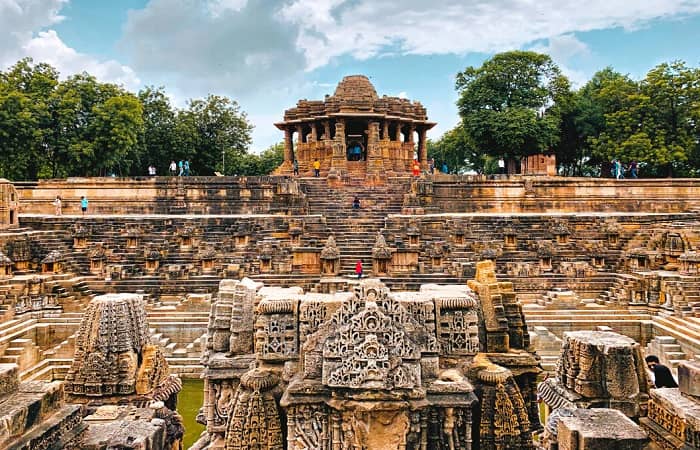
Modhera is a Surya temple which graces the banks of the holy Pushpavati River. Currently standing obsolete, this temple which is dedicated to the sun god, was created way before the Konark Sun Temple in Orissa. The walls are adorned with elaborate intricate sculptures and fine works of expert craftsmanship. The temple also has engravings depicting the epics of Mahabharata and Ramayan on the walls. Every inch of this place has a story to tell. The Surya Kund is a deep-stepped tank located in front of the temple. When the temple was under swing it used to store clean water for the locals to use. Although the stepwell is completely dried up right now, during its peak years, it used to be filled with clean water through the natural underground spring. Along with the mandapas this tank was built for the purpose to serve the pilgrims. The temple is best visited during the festive occasion of the Modhera dance festival.
8. Rani Ki Vav (Patan)
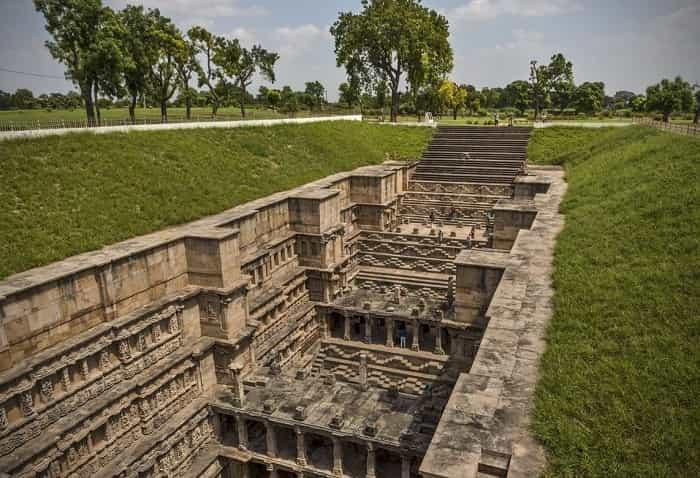
Rani Ki Vav is a UNESCO World Heritage site and is located on the banks of the holy Saraswati River. The credit for the construction of this amazing elaborate stepwell is dedicated to Udayamati who was the daughter of the king of Saurashtra, from the Solanki dynasty of Gujarat. This stepwell is an iconic heritage landmark of Gujarat and included in almost every travel plan for Gujarat. Rani Ki Vav was completely covered with silt and was later on uncovered by the archaeological survey of India which revealed a fantastic world of religion, spirituality, art, and architecture underneath. The stepwell is unique in the sense of architecture that it is made in the shape of an inverted temple with over 500 sculptures and thousands of medium and small sculptures. This underrated place has to be one of the finest examples of Indian architecture at its best.
9. Ramkund Stepwell (Bhuj)
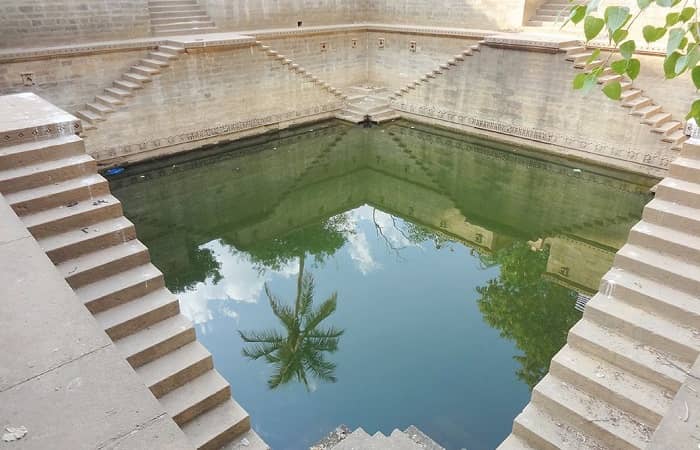
Unlike its contemporary stepwells, Ramkund falls under the more minimal and humbly decorated stepwells. It’s a lot simple, plain, and more straightforward. Currently, it holds algae water in its square tank which has a step surrounding it to lead the visitor up to the source. In the name of decoration, there are tiny miniature carved-out idols adorning the walls of the stepwell all over. These miniature idols are dedicated to Lord Vishnu and the idols represent the 10 different incarnations of the lord. Although not elaborately beautified by fine works of artistic design this vav is geometrically so perfect that it will leave you in awe. From the steps to the shape of the entire vav, it is truly a mark of what human engineering had achieved even during those ancient ages. Being located across from the Kutch Museum and Ram Dhun Temple it is an extremely rewarding experience that should be done at least once.








 Call
Call WhatsApp
WhatsApp Enquiry
Enquiry